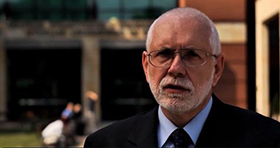Physician interviews

To download as an mp4, right-click the thumbnail and select ‘Save link as…’ or ‘Save target as…’
Apnea
Dr. Jonas Dörner discusses why he studied heart changes during apnea in free diving.
Dr. Jonas Dörner discusses the results of his study on free divers.
Dr. Lars Eichhorn describes what happens during apnea.
Dr. Claas Nähle discusses the importance of studying apnea in divers.

Alzheimer’s Disease
Dr. Cyrus Raji explains the purpose of his study on fish consumption and Alzheimer’s disease.
Dr. Cyrus Raji discusses the importance of the study on fish consumption and Alzheimer’s disease.
Dr. Cyrus Raji describes the relationship between fish consumption and healthy brain cells.
Dr. Cyrus Raji discusses the significance of his study on fish consumption and Alzheimer’s disease.
Dr. Cyrus Raji reveals the results of the study on fish consumption and Alzheimer’s disease.
Dr. Cyrus Raji describes the cause and effect of fish consumption and brain volume.
Dr. Cyrus Raji shares the findings of the study on fish consumption and Alzheimer’s disease.
Dr. Cyrus Raji describes the kinds of fish preparation that are healthiest for the brain.
Dr. Cyrus Raji explains fish preparation and its effect on the brain.
Dr. Cyrus Raji discusses the role of MRI in his study on fish consumption and Alzheimer’s disease.
Dr. Cyrus Raji explains Alzheimer’s disease and factors to help reduce or prevent the disorder.
Dr. Cyrus Raji shares the findings of the study on fish consumption and Alzheimer’s disease.
Dr. Cyrus Raji reveals how much exercise is recommended to slow the progression of Alzheimer’s.
Dr. Cyrus Raji discusses the benefits of walking in cognitive decline.

Mild-Traumatic Brain Injury (MTBI)
Mr. Thomas Malone explains mild traumatic brain injury (MTBI) and blast-induced MTBI.

Sports-Related Brain Injury
Dr. Michael Lipton reveals the findings of the study on soccer ball ‘heading’.
Dr. Michael Lipton explains what his study on soccer ball ‘heading’ involved.
Dr. Michael Lipton shares his advice as it relates to soccer ball ‘heading’.
Dr. Michael Lipton discusses the possible key to prevention against brain injury during soccer.
Dr. Michael Lipton discusses how to protect the brain against injury during soccer.
Dr. Michael Lipton reveals the brain findings of the study on soccer ball ‘heading’.
Dr. Michael Lipton describes traumatic brain injury.
Dr. Michael Lipton discusses what his study on soccer ball ‘heading’ examined.
Dr. Michael Lipton discusses brain repair and regeneration.
Dr. Michael Lipton reveals treatment options for brain injury.
Dr. Michael Lipton describes diffusion tensor imaging (DTI).
Dr. Michael Lipton discusses what diffusion tensor imaging (DTI) helps detect.
Dr. Michael Lipton discusses why soccer players were studied in his research on brain injury.
Dr. Michael Lipton discusses why soccer was selected for his research on head injury.
Dr. Michael Lipton describes the methodology of the study on soccer ball ‘heading’ and brain injury.
Dr. Michael Lipton reveals the results of the study on soccer ball ‘heading’ and brain injury.
Dr. Michael Lipton shares the findings of the study on soccer ball ‘heading’ and brain injury.
Dr. Michael Lipton reveals the next steps for his study on soccer ball ‘heading’ and brain injury.
Dr. Michael Lipton discusses brain injury prevention methods during soccer play.
Dr. Michael Lipton shares his recommendations to prevent brain injury during soccer.
Dr. Alexander Lin explains chronic traumatic encephalopathy (CTE).
Dr. Alexander Lin describes the symptoms of chronic traumatic encephalopathy (CTE).
Dr. Alexander Lin explains the procedure for diagnosing chronic traumatic encephalopathy (CTE).
Dr. Alexander Lin explains what happens during MR spectroscopy.

Breast Cancer Screening
Dr. Alison Chetlen discusses which parts of the body they measured scattered radiation.
Dr. Alison Chetlen discusses the findings of her study on the potential impact of scatter radiation during mammography.
Dr. Alison Chetlen explains why she recommends against using thyroid shields during a mammogram.
Dr. Stamatia Destounis explains what's new about her study on mammography screening at age 40.
Dr. Stamatia Destounis explains the public impact of her study on mammography screening at age 40.
Dr. Stamatia Destounis discusses why she conducted her study on mammography screening at age 40.
Dr. Stamatia Destounis addresses recent reports advising against screening for women in their 40s.
Dr. Stamatia Destounis discusses mammography screening for women in their 40s.
Dr. Emily F. Conant explains who would benefit most from digital breast tomosynthesis (DBT).
Dr. Emily F. Conant explains the term "callback”, in regards to screening mammography.
Dr. Emily F. Conant explains the advantages and benefits of digital breast tomosynthesis (DBT).
Dr. Bonnie N. Joe discusses why she conducted research on risk-based screening in women aged 40-49.

Pregnancy Complications
Dr. Patrick Nicholson explains the condition, placenta accreta.
Dr. Patrick Nicholson explains the risks to mother and baby associated with placenta accreta.
Dr. Patrick Nicholson explains the prophylactic internal artery balloon treatment and how it works.
Dr. Patrick Nicholson explains radiology’s role in treating women with placenta accreta.
Dr. Andrzej Urbanik discusses the negative effects of alcohol consumption during pregnancy.
A brief overview of the methodology used in Dr. Andrzej Urbanik’s study on fetal alcohol exposure and its effects on the brain.
A brief synopsis of the methodology used in Dr. Andrzej Urbanik’s study on fetal alcohol exposure and its effects on the brain.

Face Transplatation
Dr. Frank J. Rybicki explains the purpose of their research on full face transplantation.
Dr. Frank J. Rybicki explains the use of CT angiography on face transplant patients.
Dr. Frank Rybicki explains why computed tomography (CT) is critical to making a 3-D model.
Dr. Vijay Gorantla explains face transplantation.
Dr. Vijay Gorantla explains how the face functions after transplantation.
Dr. Joseph Losee discusses the field of face transplantation.
Dr. Joseph Losee describes the types of reconstructive transplantation.
Dr. Joseph Losee shares the history of face transplantation.
Dr. Joseph Losee explains the challenges associated with face transplantation.
Dr. Joseph Losee describes how the face functions after transplantation.
Dr. Joseph Losee describes how the nerves in the face function after transplantation.
Dr. Darren Smith discusses combining various imaging modalities.
Dr. Darren Smith explains how models of the face are generated for transplant planning.
Dr. Darren Smith discusses how facial features are reconstructed.

Obesity
Dr. Miriam Bredella discusses the most important finding from her study on visceral obesity in men.
Dr. Miriam Bredella discusses why the research in her study focused on obese men.
Dr. Miriam Bredella discusses what kind of fat is most damaging to bone strength.
Dr. Miriam Bredella discusses how finite element analysis (FEA) is used in assessing bone strength.
Dr. Miriam Bredella discusses how to prevent bone degeneration.
Dr. Miriam Bredella discusses the difference between visceral and superficial belly fats.
Dr. Miriam Bredella discusses what’s new about her research on bone health in obese women.
Dr. Miriam Bredella reveals the methodology and results of her study on bone health in obese women.
Dr. Miriam Bredella describes the public impact of her study on bone loss and obesity.
Dr. Miriam Bredella discusses an unexpected finding in her study on bone health and obese patients.
Dr. Miriam Bredella describes who can benefit from hormone replacement.
Dr. Miriam Bredella discusses the risks associated with growth hormone replacement.
Dr. Mubin Syed explains how gastric artery embolization is performed.

Osteoarthritis
Dr. Thomas Link explains how too much or too intense physical activity can be detrimental for knees.
Dr. Thomas Link explains the purpose of the study on exercise and osteoarthritis.
Dr. Thomas Link reveals the results of the study exercise and osteoarthritis.
Dr. Uwe Schütz explains the importance of his study on long-distance runners.

Heart Disease
Dr. John Nance discusses how his research on gender differences in heart attack risk differs from prior studies.
Dr. John Nance describes the public impact of this study on the gender differences in heart attack risk.
Dr. John Nance explains why he conducted a study on differences in heart attack risk.
Dr. John Nance reveals the most compelling finding of his study on differences in heart attack risk.
Dr. John Nance discusses an unexpected finding in his study on heart attack risk.
Dr. John Nance offers advice to women and men worried about cardiovascular risk.
Dr. John Nance discusses when men are at greater risk for major cardiac events.


